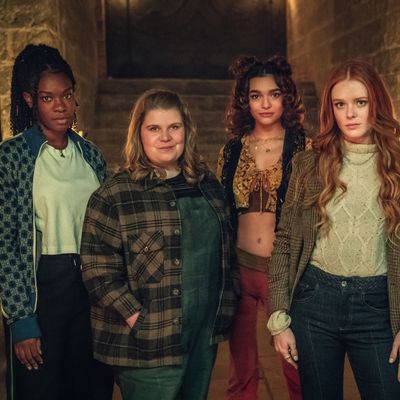
This September marked the return of a few important things in my life: soup, crisp autumnal weather, and Fate: The Winx Saga. That last one couldn’t have arrived at a better time; Fate may be based on a cartoon meant for children, but it is the perfect cozy-weather binge-watch for every age range. Allow me to explain.
As kids, my sister and I had a weekend-morning tradition: Upon waking, we’d zoom to the guest room of our house, which contained a box television set and a permanently blown-up air mattress. We’d perch on the edge of the mattress, turn on the TV, and flip to the local-access channel that aired 4KidsTV (our parents didn’t believe in cable), where we’d watch our version of Saturday morning cartoons: a double feature of Totally Spies! and Winx Club.
We were especially obsessed with Winx Club. I was the type of child who scanned the back covers of books for any mention of fairies, witches, or mermaids, and my sister, Stella, shared a name with one of the fairy characters in the show. When we played pretend afterward, attempting to run up and roll down our air-mattress ramp, Stella always got to be Stella, and I’d inhabit the other five — Bloom, Musa, Aisha, Tecna, and Flora — as I pleased. Those mornings are some of my favorite childhood memories.
So when, in January of 2021, I was looking for something to watch on Netflix and was fed the trailer for Fate: The Winx Saga — a live-action series based on the cartoon I loved as a child — it was a skeptical but near immediate click of the PLAY button.
To be clear, I did not think this show was going to be capital-G Good. I was expecting the immersive, guffaw-drawing absurdity of Riverdale, and it did give me a good laugh watching the opening scene, in which a tortured Bloom arrives at Alfea, confused and giving off waves of main-character energy. She tells her future love interest, Sky, that she’s from the realm of California and that mansplaining “kinda seems like your thing.” The delightfully corny dialogue continued, but as I inhaled the season, I found myself becoming genuinely invested in a way I hadn’t expected.
It turns out that the original creator of the cartoon series, Italian animator Iginio Straffi, made it because he didn’t see any action-oriented cartoons for girls starring female characters as the heroes. And as he pointed out in an interview with Polygon, it was one of very few western cartoons with a narrative arc, character development, and complex plot turns. Rewatching some of the old episodes recently, I was impressed by how much I still enjoyed them.
The Netflix adaptation of Fate: The Winx Saga is a liberal interpretation of its source material; the basic premise of a group of fairies attending a magical boarding school called Alfea remains, but little else does. The characters are slightly altered; we’ve still got our fire fairy, Bloom, and Stella, the princess of Solaria. Musa and Aisha (emotion and water fairies, respectively) also remain. But there’s no Tecna; instead, we have earth fairy Terra, whose cousin Flora, also an earth fairy, comes along in season two.
The first episode also includes a Harry Potter reference — the fairies of Alfea are evidently all well-versed in Earthly cultural phenomena — and in some ways, the show shares Harry Potter’s general vibes. There’s a special “chosen one” character who wasn’t raised among her kind and therefore spends much time brooding, and it is extremely autumnal — we’ve got stone structures, a dense forest that borders the school and contains scary creatures, and partly cloudy weather that always seems to require a light jacket (the show was filmed in Ireland).
Beyond the “How do you do, fellow kids?”–ness of some of the dialogue, the show is thoughtfully written. In the same way that the original cartoon valued character development, Fate watches its fairies (and Specialists, their non-magical male counterparts) evolve as individuals and within their relationships. Fantasy shows have a tendency to offer a black-and-white, good-versus-evil perspective on morals and motivations, but this one is as comfortable in the gray area as it is with gray weather.
Also, for lack of a better term, it’s horny — the opposite of a cutesy fairytale romance (I’m sorry! I had to say it). These fairies fuck. Bloom’s love interest, Sky? Also Stella’s ex-boyfriend. Elsewhere, two Specialists, Riven and Dane, get into a throuple with a complex, sort-of-but-not-totally-evil fairy, Beatrix. Dane is in love with Riven, Riven wants Beatrix, and Beatrix wants them both. Musa is secretly dating Terra’s brother, Sam. And that’s just season one!
The sexy drama of it all occurs against a backdrop of potentially world-ending threats to the realm of Solaria, and Bloom’s determined mission to figure out where she comes from (her fairy origins are shrouded in mystery). She will stop at nothing to discover who she really is.
On one hand, Fate: The Winx Saga is ultimately a silly little show about fairies. I love it for that. I also love it because it’s pretty good. Okay? It’s good. It’s a good show, and I stand by that. I will never be too old for a little bit of pretending.



